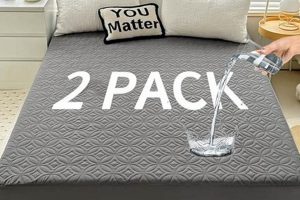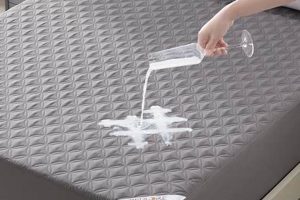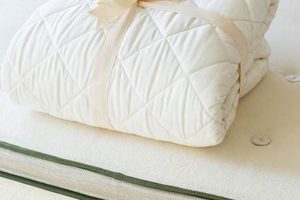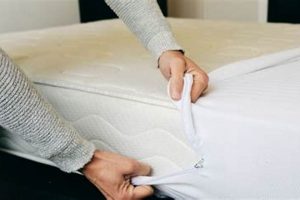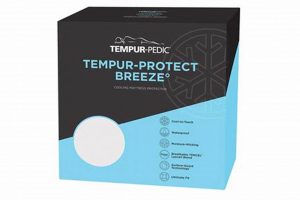A removable fabric layer designed to shield a bed’s sleeping surface from spills, stains, allergens, and general wear is a valuable bedding accessory. For example, this protective layer prevents liquids from penetrating the mattress, thus prolonging its lifespan and maintaining its hygiene.
Regular care of this barrier is paramount. Maintaining a clean sleep environment contributes significantly to respiratory health and minimizes exposure to dust mites and other allergens. Furthermore, preventing permanent staining preserves the mattress’s appearance and potentially its warranty.
The subsequent sections will detail the recommended methods for cleaning this item, covering frequency, suitable cleaning agents, drying techniques, and essential considerations to ensure its continued protective function.
Washing a Mattress Protector
Proper cleaning ensures the continued efficacy of the protective layer. Adhering to the following guidelines maximizes hygiene and prolongs the product’s lifespan.
Tip 1: Consult the Care Label: Prior to initiating any cleaning process, thoroughly review the manufacturer’s care instructions. This label provides specific guidance regarding water temperature, detergent type, and suitable drying methods. Deviating from these instructions may compromise the protector’s integrity.
Tip 2: Frequency of Washing: Under normal circumstances, wash the protector every one to two months. More frequent washing may be necessary in cases of spills, accidents, or for individuals with allergies.
Tip 3: Pre-Treating Stains: Address any visible stains promptly. Apply a mild stain remover or a solution of diluted laundry detergent to the affected area prior to placing the protector in the washing machine. Allow the solution to sit for approximately 15-30 minutes before washing.
Tip 4: Washing Machine Settings: Use a gentle cycle with cold or lukewarm water. High temperatures may damage the protector’s waterproof or stain-resistant properties. Ensure the protector is thoroughly rinsed to remove all detergent residue.
Tip 5: Detergent Selection: Opt for a mild, hypoallergenic laundry detergent. Harsh chemicals or bleach can degrade the protector’s fabric and potentially irritate sensitive skin.
Tip 6: Drying Techniques: The preferred method for drying is to tumble dry on a low heat setting. Avoid high heat, as this can cause shrinkage or damage to the waterproof lining. Alternatively, the protector can be air-dried on a clothesline or drying rack, ensuring it is completely dry before placing it back on the mattress.
Tip 7: Inspect for Damage: Before reinstalling the protector, carefully inspect it for any signs of wear and tear, such as rips, tears, or peeling of the waterproof layer. Replace the protector if significant damage is evident.
Following these guidelines ensures a clean and hygienic sleeping environment and extends the life of this important bedding component.
The subsequent section will discuss common issues and solutions related to maintaining this bedding item.
1. Material Composition
The material composition of a mattress protector fundamentally dictates its washability and the appropriate cleaning methods. Different fabrics respond differently to water, heat, and detergents, impacting the protective layer’s structure and performance. For instance, a protector constructed primarily of cotton can generally withstand frequent machine washing and drying without significant degradation. In contrast, protectors incorporating polyurethane or vinyl for waterproofing often require gentler handling, such as lower water temperatures and air drying, to prevent delamination or cracking.
The choice of materials directly affects the care requirements and the lifespan of the protector. For example, protectors utilizing blended fabrics, such as polyester and cotton, may offer a balance of durability and ease of care, while those featuring specialized fabrics like bamboo or Tencel possess inherent antimicrobial properties but might necessitate specific detergents to avoid damaging these attributes. The presence of laminated layers, such as waterproof membranes, introduces additional considerations, as excessive heat can compromise the adhesive bonds, leading to separation and reduced protection.
Understanding the material composition is therefore essential for determining the appropriate washing protocol and maintaining the integrity of the mattress protector. Neglecting this aspect can result in diminished performance, premature wear, and ultimately, the need for more frequent replacement. Consulting the care label, which specifies the fabric blend and recommended cleaning instructions, is crucial to ensuring optimal hygiene and preserving the protector’s functionality.
2. Care Label Instructions
The care label affixed to a mattress protector serves as the definitive guide for its proper maintenance, directly influencing its washability. Disregarding these instructions can lead to irreversible damage, voiding warranties and compromising the protector’s ability to safeguard the mattress. For example, a protector labeled “Dry Clean Only” will likely sustain significant damage if subjected to machine washing. Conversely, attempting to dry clean a protector intended for machine washing may not adequately remove allergens or stains.
The instructions provided on the care label are formulated based on the specific materials used in the protector’s construction, including the outer fabric, the waterproof membrane (if present), and any binding or stitching. These instructions dictate optimal water temperature, suitable detergent types, permissible drying methods, and whether ironing is allowed. Adhering to these guidelines ensures the protector is cleaned effectively without compromising its structural integrity or functional properties. Consider a scenario where a care label specifies cold water washing to preserve the waterproof lining; using hot water could cause the lining to delaminate, rendering the protector ineffective against spills.
In conclusion, care label instructions are not mere suggestions but rather essential directives for preserving the quality and effectiveness of a mattress protector. Ignoring them constitutes a significant risk, potentially leading to premature wear, reduced protection, and the need for earlier replacement. Consistent adherence to the manufacturer’s recommendations ensures a clean, hygienic sleeping environment and extends the lifespan of both the protector and the underlying mattress.
3. Washing Frequency
The frequency with which a mattress protector is laundered directly impacts its hygiene, longevity, and continued protective capability. Establishing an appropriate washing schedule is essential for maintaining a clean sleep environment and preserving the integrity of the protector’s materials.
- Allergen Control
Regular laundering removes accumulated dust mites, pet dander, pollen, and other allergens. The frequency should increase for individuals with allergies or respiratory sensitivities, potentially requiring weekly washing. Inadequate washing allows allergen buildup, negating the protector’s intended benefit.
- Stain and Spill Management
Prompt washing following spills or accidents is crucial to prevent permanent staining and odor retention. Delayed cleaning allows liquids to penetrate the protector’s fibers, potentially compromising its waterproof barrier and necessitating more aggressive cleaning methods that could damage the material. Immediate attention minimizes the risk of irreversible damage.
- Material Degradation
Overly frequent washing can accelerate the wear and tear of certain materials, particularly those with waterproof coatings or delicate fibers. Each wash cycle subjects the protector to mechanical stress and chemical exposure from detergents. Following the manufacturers guidelines regarding washing frequency minimizes unnecessary degradation.
- Hygiene Maintenance
Even without visible stains or spills, regular washing removes accumulated body oils, sweat, and dead skin cells. These substances provide a breeding ground for bacteria and contribute to unpleasant odors. Periodic cleaning, typically every one to two months, maintains a hygienic sleep surface.
Ultimately, determining the optimal washing frequency involves balancing the need for cleanliness and allergen control with the potential for material degradation. Adhering to the care label instructions and adjusting the schedule based on individual needs and circumstances ensures that the mattress protector effectively fulfills its intended function of safeguarding the mattress while promoting a healthy sleep environment.
4. Water Temperature
The water temperature employed during the laundering process significantly affects the structural integrity and performance of the protective bedding layer. Selecting an appropriate temperature is crucial for effective cleaning without compromising the material’s properties or waterproof capabilities.
- Fabric Shrinkage
Elevated water temperatures can induce shrinkage in certain fabrics, particularly natural fibers like cotton. Significant shrinkage alters the protector’s dimensions, rendering it ill-fitting and potentially ineffective at fully covering the mattress. Following the manufacturer’s recommendations mitigates this risk.
- Waterproof Membrane Degradation
Mattress protectors featuring a waterproof membrane, often constructed from polyurethane or vinyl, are susceptible to damage from high heat. Exposure to elevated water temperatures can cause the membrane to delaminate, crack, or lose its waterproof properties. Washing in cold or lukewarm water is generally advised to preserve the membrane’s functionality.
- Detergent Activation
Different detergents require specific water temperatures to activate effectively. Some detergents perform optimally in warm water, while others are formulated for cold water use. Matching the detergent type to the water temperature ensures thorough cleaning and stain removal. Using cold water with a detergent designed for warm water may result in inadequate cleaning.
- Colorfastness
Hot water can cause dyes to bleed from colored fabrics, leading to fading or discoloration. Washing the mattress protector in cold or lukewarm water helps to preserve its original color and prevent dye transfer to other items in the wash. This is particularly important for protectors with vibrant colors or intricate patterns.
Therefore, water temperature is a critical parameter in the care of a mattress protector. Adherence to the care label’s guidance on water temperature optimizes cleaning effectiveness while minimizing the risk of damage to the fabric, waterproof membrane, and overall integrity of the bedding component. Consistent application of appropriate washing protocols extends the life and protective capabilities of the mattress protector.
5. Detergent Type
The selection of detergent directly influences the outcome of laundering a mattress protector and, consequently, its continued effectiveness. The detergents chemical composition determines its cleaning efficacy and its potential impact on the fabric’s integrity, waterproof barrier, and overall performance. For instance, using a harsh detergent containing bleach on a protector with a delicate waterproof lining could degrade the lining, compromising its ability to prevent liquid penetration. Conversely, a mild detergent might be insufficient for removing stubborn stains or deeply embedded allergens.
The type of material comprising the protector necessitates careful consideration of the detergent’s formulation. Enzyme-based detergents are effective at breaking down organic stains such as blood or sweat, but may be too aggressive for sensitive fabrics like bamboo or Tencel. A pH-neutral detergent is often recommended for delicate fabrics to minimize the risk of damage or discoloration. The presence of a waterproof membrane also requires attention. Some detergents contain chemicals that can degrade the membrane over time, reducing its ability to prevent liquid from reaching the mattress. A clear example is using fabric softeners, which can leave a residue that impairs the waterproof properties of certain protectors.
In summary, selecting the appropriate detergent is a critical step in maintaining a mattress protector. The optimal choice balances cleaning effectiveness with the need to preserve the protector’s material integrity and waterproof capabilities. Careful consideration of the fabric type, waterproof membrane, and potential irritants ensures the protector remains hygienic and continues to fulfill its intended function. Prioritizing gentle, hypoallergenic, and residue-free detergents contributes to both the longevity of the protector and a healthy sleep environment.
6. Drying Method
The selection of a drying method is inextricably linked to the successful maintenance of a mattress protector following washing. The chosen approach directly influences the protector’s structural integrity, its continued ability to function as a barrier against liquids and allergens, and its overall lifespan. Improper drying techniques can negate the benefits achieved through careful washing, leading to shrinkage, delamination of waterproof layers, or permanent damage to the fabric. A practical example is exposing a protector with a polyurethane waterproof membrane to high heat in a dryer. This can cause the membrane to crack or separate from the fabric, rendering it ineffective and potentially releasing harmful chemicals.
Specific materials necessitate particular drying protocols. Cotton protectors often tolerate machine drying on moderate settings, while those incorporating delicate fibers like bamboo or Tencel, or featuring waterproof linings, typically require air drying or tumble drying on the lowest heat setting. Air drying, although time-consuming, minimizes the risk of shrinkage and heat damage. Tumble drying, when performed correctly, can expedite the process while still preserving the protector’s integrity. The use of dryer sheets should be approached with caution, as certain varieties may leave a residue that diminishes the waterproof capabilities or attracts allergens. The method should promote thorough drying to prevent mildew or unpleasant odors.
In summary, the drying method is not merely a final step in the cleaning process but a critical determinant of a mattress protector’s long-term functionality. Adherence to the care label’s drying instructions is paramount to preserving the protector’s material integrity and ensuring its continued ability to safeguard the mattress. Understanding the implications of different drying techniques empowers responsible care and maximizes the investment in this essential bedding component. The selection must ensure the product is dried completely.
7. Waterproof Integrity
The preservation of waterproof integrity is paramount to the continued effectiveness of a mattress protector. The protector’s ability to repel liquids and prevent them from reaching the mattress directly correlates to its hygiene and the mattress’s longevity. Washing practices significantly influence this critical function.
- Membrane Durability
The waterproof barrier, typically a laminated or coated layer, is susceptible to degradation during washing. Repeated exposure to harsh detergents, high temperatures, and aggressive agitation can compromise its structure. Cracking, peeling, or delamination of the membrane diminishes its protective capabilities. Compromised integrity means spills and accidents will permeate to the mattress.
- Seam Reinforcement
Seams represent vulnerable points in a mattress protector’s waterproof design. Inadequate seam reinforcement or deterioration of seam sealant during washing creates pathways for liquid penetration. Reinforcing seams ensures a continuous barrier. Unsealed seams will allow liquid penetration, thus compromising the mattress.
- Material Compatibility
The compatibility of the protector’s outer fabric with the waterproof membrane is critical. If the outer fabric shrinks excessively during washing while the membrane remains unchanged, stress can develop, leading to membrane failure. Different materials can have different wash settings. Incompatible materials will lead to failure of waterproof functions.
- Post-Wash Inspection
A thorough inspection following each wash is essential to identify any breaches in the waterproof barrier. Visual examination for cracks, tears, or delamination, as well as a water test, can reveal subtle compromises that might otherwise go unnoticed. Early detection allows replacement. This is critical for checking the waterproof status.
Maintaining waterproof integrity is not merely about selecting the appropriate washing conditions; it involves a holistic approach that considers material compatibility, seam reinforcement, and vigilant post-wash inspection. The ability to effectively wash a mattress protector without compromising its waterproof function ensures a clean, hygienic sleeping environment and protects the underlying mattress from damage and contamination.
Frequently Asked Questions About Washing Mattress Protectors
This section addresses common inquiries regarding the proper cleaning and maintenance of mattress protectors to ensure their continued effectiveness and longevity.
Question 1: How often should a mattress protector be washed?
Under typical conditions, a mattress protector warrants cleaning every one to two months. More frequent washing may be necessary in instances of spills, accidents, or if individuals using the bed suffer from allergies. Washing too frequently can lead to the breakdown of the mattress protectors material. Frequency should be determined based on the specific item.
Question 2: What water temperature is recommended for washing a mattress protector?
Cold or lukewarm water is generally advised. High temperatures can damage the waterproof lining and cause shrinkage of the fabric. The care label provides specific instructions for the protector in question.
Question 3: Is it permissible to use bleach on a mattress protector?
Generally, the use of bleach is discouraged. Bleach can degrade the fabric and potentially compromise the waterproof layer. Opt for mild, hypoallergenic detergents instead.
Question 4: Can a mattress protector be placed in a dryer?
The care label determines drying method. Low heat settings are sometimes acceptable. Air drying is a safe alternative to prevent damage to the waterproof lining or shrinkage of the fabric.
Question 5: What type of detergent is most suitable for cleaning a mattress protector?
A mild, hypoallergenic detergent, free of harsh chemicals, is recommended. Such detergents minimize the risk of damaging the protectors fabric or irritating sensitive skin.
Question 6: How can stains be effectively removed from a mattress protector?
Pre-treating stains with a mild stain remover or a diluted solution of laundry detergent prior to washing is recommended. This should allow the solution to sit for approximately 15-30 minutes. It is important to consult the care label, as some stain removers may not be compatible.
In summary, adhering to the care label instructions and employing gentle cleaning methods is essential to maintaining the integrity and effectiveness of a mattress protector.
The following section will provide insights on troubleshooting common issues related to mattress protectors and their care.
Can You Wash a Mattress Protector?
The preceding exploration has illuminated the critical factors influencing the proper care of mattress protectors. Material composition, adherence to care label directives, washing frequency, water temperature, detergent selection, drying method, and preservation of waterproof integrity are all crucial determinants of both hygiene and longevity. Neglecting any of these aspects can compromise the protector’s functionality and necessitate premature replacement.
Therefore, meticulous attention to these guidelines is essential for maintaining a clean and healthy sleep environment and maximizing the lifespan of the investment. Informed cleaning practices not only safeguard the mattress but also contribute significantly to overall well-being.


